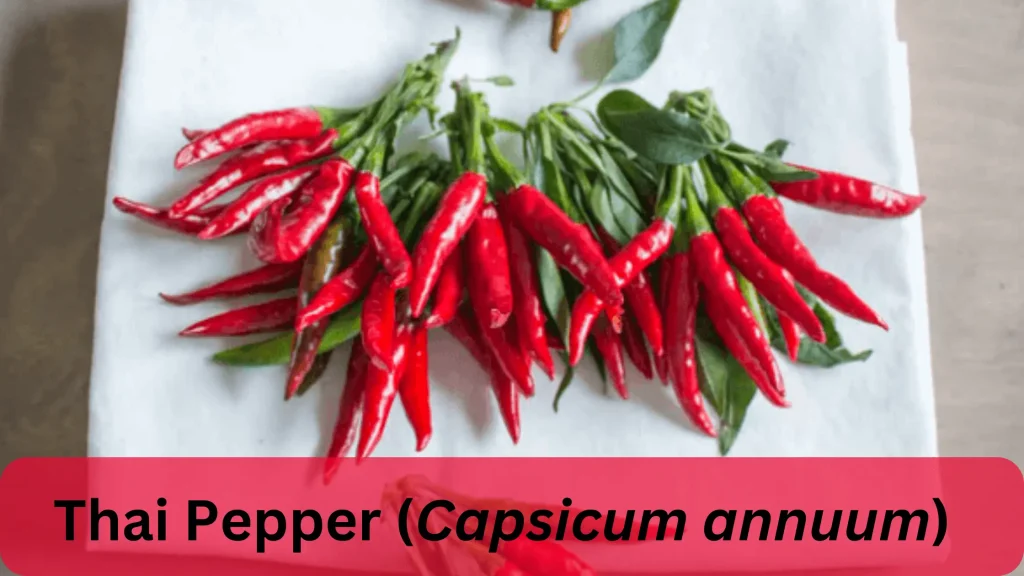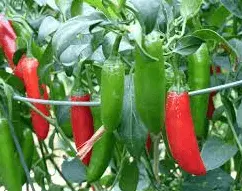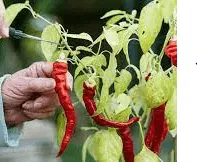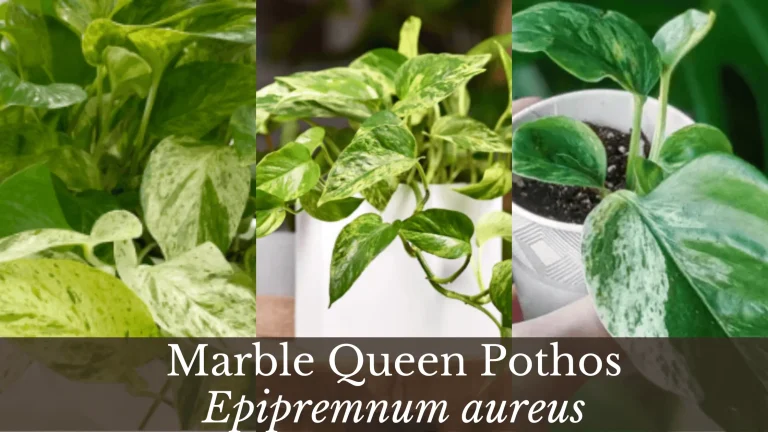Thai Pepper | Characteristics, Types, How to grow and Care
Would you like to try sweet with the heat? Have you heard about the Thai Pepper (Capsicum annuum) also known as “Bird’s Eye”. This pepper is just 1.5-2 inches long but it contains 20-25 seeds, hot and spicy. These spicy and hot seeds make its Scoville Rating more than 100,000. Moreover, these mature, red, and spicy chilies are hot even than the red bell pepper.
Important Information about Thai Pepper
Following table shows some of the basic information about the Thai Chili Pepper.
| Common Name | Bird Eye / Thai Pepper |
| Scientific Name | Capsicum annuum |
| Family | Solanaceae |
| Pepper Size | 1.5-2 inches long |
| Seeds | 20-25 seeds/fruit |
| Germination Time | October to November |
| Weather | Hot Humid |
| Areas (Hardness Zones) | 9, 10, and 11 (USDA) |
| Native Areas | United States and Maxico |
| Soil | Well Drained with 5.5 to 6.5 pH |
| Germination duration | 10-14 days |
| Time to Maturity | 85-130 Days |
| Sowing Depth | 0.5 Inch deep In the soil mix planter |
| Temperature | 70-95F |
| Planting Space | 15-18 Inches apart |
| Row Spacing | 2.5 – 3 feet apart |
| Maximum Plant Height | 1 feet (12 inches / 30 cm) |
| Spread | 7-10 inches |
| SHU (Scoville Heat Unit) | 100,000 SHU (Extremely Hot and Spicy) |
This plant perform well in pot. You can you a 2 feet deep pot, filled with planter mix and place it in the sunny area. In most of the nurseries, this pot is sold as an ornamental pot and you can get its fruit as well. So, this serves as for aesthetic values and edible purposes as well.
In your courtyard, it is recommended to handle the pot, plant, and the fruit with care using gloves. Not only the edible part but also its handling may cause irritation on the skin where touched. Thus keep it in mind to be safe while watering and picking fruit.

How Hot is a Thai Pepper?
There are about 80 varieties of Bird’s eye pepper and thus it has a wide range of hotness and taste sense. However, we can tell the hotness in the SHU (Scoville Heat Units). For this, the units range from 50,000 to 100,000 SHU. You can imagine how hot Thailand chili pepper is by comparing it with a typical Jalapeno Pepper. A common pepper may have range of SHU from 5000 to 8000 while Thai pepper is 12 to 20 times hotter than a common pepper.
Note:
Red Bell Pepper measures Zero “0” SHU
My Experience with Thai Peppers
To have experience of its plantation and taste, I have grown 15 plants in pots at my home. I planted them in soil form the first 25 days and then planted them into 2 feet deep and 8 inch wide pots. They grow very well and proved productive.
Every plant produced 35 to 50 fruits. However, I examined that the fruits are a bit longer. Their average length was more than 3 inches surprisingly. I dried them in sun and made chili flakes and powder to be used in the kitchen.
Types of Thai Pepper
This hot and spicy pepper can grow in wide range of soil type and temperature. It is adopted to different zones and thus have evolved different types. There are more than 70 different varieties of Thai Pepper. All these species have been evolved from the red and green peppers of Thailand.
- Prik Num (Banana Pepper) – These are also known as Kashmir pepper or Mexican pepper as they are equally grown there. These are edible and moreover, are used to make Sauce “Sriracha”.

Prik Num (Banana Pepper)
2. Prik Yuak – This type is mild hot.it is successfully grown in India and Mexico.

Prik Yuak – Thai Pepper
3. Prik Leuang – I can grow well in mild temperatures and moderate climate. It is mild hot in taste. People of India use this as Pickle.

Prik Leuang
4. Prik Kee Noo – This is one of the most hot and spicy variety of Bird’s Eye Pepper.

Prik Kee Noo
5. Prik Chee Fah – It is subclass of Green and Red Varieties of Thai Chilies. They are mild in taste.

Prik Chee Fah
6. Prik Jinda – Another hot Chilly species.

Prik Jinda – Thai Chili Peper
7. Serrano Capsicum – Thick fleshed red pepper. This is equal to Thai Pepper in Heat.

Serrano Capsicum
8. Tabasco Capsicum – Thin flesh red in colour with sharp and biting flour.

Tabasco Capsicum
9. Korean Capsicum – Thai Cousin Pepper, green in colour and slightly long, about 3-4 inches long.

Korean Capsicum
10. Cayenne Capsicum – It is used in dried form. Bitter and smoky in colour.

Cayenne Capsicum
Of these 6 varieties out of 79, only 2 grows well in Thailand. Prik Kee Noo (Bird Pepper) and Prik Kee Fah (Plain Chili) grows in the Agriculture lands of Thailand.
How to Grow Thai Chili Pepper?
There are two method being followed to grow these pepper. However for either type, you can grow the seed in the seed trays and then transplant it into field, on the beds, on in the pots.
How to plant Thai Pepper in Seed Trays?
To escape the forest injury to the young seedlings, you can grow the seeds in seed trays under your intensive care and control.
Material Required
You can start this with;
- Germination Trays
- Small Pots
- Potting mix / Soil
- Humus / Compost
- Heat mat
- Light source
Method of Sowing in Seed Trays
- Fill the trays with potting mix or soil. The planting material must be with some moisture content.
- Plant single seed in one pot. Burry it in ¼ inches deep soil. Press it and add some potting material.
- Now comes the turn of Heat map and Light source. Give it 8-10 hours light and 80-85F temperature. Place then in windows for sunlight as well.
- Keep soil moist until the germination.
- Germination will occur in 8-15 days.
- When the seedlings are 20-25 days old, uproot them and shift to bigger pot or field.
Planting in Soil
For planting in soil;
Time – Whether you are planting in soil or in pot, you must consider the best time to get 100% germination. Always spread seeds when the temperature is around 60-75F. Always try to do this before the frost or you have to cover the new born seedlings.
Site – It grows well in Hardness zones 9-11 USDA (United States Department of Agriculture). In these zones, try to select a location where day light length is more than 7-9 hours.
Soil – A well-drained soil with slightly acidic pH (5.5-7) is perfect. Add organic amendments in to meet the nitrogen deficiency.
Sowing Method and Spacing – These can be grown on the leveled ground or raised beds. Plant to plant distance can be 1-2 feet apart in rows 2-2.5 feet apart. Sow seed 1/2 inch deep in the soil.
Support – Plant can grow upto 1 feet in height thus it doesn’t require proper support. However, in the raised bet, try to cover the root zone with soil.
Planting in Pot
As these are small in size, with attractive flowers and fruits, some may love to grow these in pots. Moreover, growing these peppers in pot is also a successful way to get chilies for your own kitchen.
Container Size – Get a plastic or Clay pot with perforations. The depth of the pot should be 12-15 inches.
Planting Material – You can use soil or planter mix. However to improve the productivity, the soil should be mixed with coco peat, moss, or other organic and composted material.
Planting Process – Make a planting hole and bury the seed 0.5 inches deep, press the soil firmly and irrigate it.
Water – Apply water twice in a day for the potted plants. Irrigate for 4-6 weeks and once the fruiting starts, stop irrigation.
Fertilization – If you have added organic fertilizer, there is a little requirements for the inorganic fertilizers. It is recommended to use liquid fertilizers.
Plant Care – When plant reaches maturity, do earthing up regularly so that it may not bend or lodging.
Tip:
For sun drying, keep then in open sunlight. Always keep checking for the one decomposing, discard them to save the quality of the produce. This sun drying process will take 12-15 days.
We will study plant care in details in following section;
How to Care for Thai Pepper Plant?
Thai chili plant is frost, temperature, and day light sensitive. It requires intensive care. You need to consider all the following aspect for successful growing and yield.
Seed – Always plant health seed. Consider the climate requirements and area before selecting seed for germination. There are different varieties like; Serrano, Tabasco, Korean, and Cayenne.
Light – This Plant require 8-10 hours day light. For this, always place it facing southward. Avoid placing them under shade.
Soil – Well drained enriched in organic matter soil will give high produce. Potting mix and humus mixed soil can also serve better. Soil pH must be in the range of 5.5-6.5.
Water – At soil, soil must be with some moisture content. In case you have planted it in soil, irrigate it after every 2-3 days. However, where planning is in pots and trays, irrigate it twice in a day. You can also choose drip irrigation.
Temperature – For better germination, it require 65-80 degrees F temperature. However, night temperature must not go below 60 degrees F otherwise, yield will be compromised.
Humidity – As in the germination phase, plant is covered so it will be high in humidity. About 50-55% humidity is sufficient. You can check and maintain it using Hygrometer (Moisture Meter).
Fertilizer – It doesn’t require fertilizer at the time of sowing. However, after germination, slight application of fertilizer (NPK – 5:10:10) would be sufficient. Add calcium based fertilizers at the time of maturity and flowering.
Pollination – Try to attract pollinators to your greenhouse (Dome). Peppers require wind and bee pollinators. You can also add some flowers to attract pollinators.
Companion Crops – For pollination, you can grow companion crops like; Petunia, Marigold, Paarsley, Chive, and Nasturtium.
Harvesting – At maturity, they turn green and then red. You can harvest in any form. Always try to pick red chilies with snipper. Never use hands pick method. Cut some stem part as well otherwise the quality will deteriorate in a couple of days.
Warning:
Handling them may cause burning sensation. Always use gloves and avoid touching your skin while handling plants.
Pest – Protect your plant form the sap-sucking pests like aphids and mites. You can use a repellent or soap spray. Pepper weevil is also a potential insect. It lays eggs in flowers and larvae may make tunnels in the fruits, destroying them completely. For control;
- Remove affected fruits
- Practice garden sanitation and cleaning to destroy the habitat of insects
- Practice crop rotation
Diseases – Fungal, viral, and bacterial disease may also ruined the yield of Thai Chili. Diseases include; mosaic viruses, powdery mildew, bacterial wild, etc. these disease can be controlled by;
- Applying fungicides for fungal diseases
- Provision of best growing season with appropriate humidity.
Conclusion
Thai Pepper (Capsicum annuum / “Bird’s Eye”) grow well in the United States (South America) and Mexico. It is hot and spicy with SHU 100,000 or so. It range in size from 1.5-2 inches. It can be used in vegetables and sauces. Well drained soil with 5.5 pH and optimum fertility status will work perfect. It can be grown in soil and in pots as well. Keep the pots in light to get 8-10 hours light period in a day. It has about 79 species, all are highly productive. Grow them for kitchen gardening and have a good and pure taste.
FAQs
How many scoville units is a Thai chili pepper?
The SHU ranges from 50,000 to 100,000. These units shows that it is 15-20 times hotter then the red bull and other chili varieties.
How hot is a green Thai chili pepper?
Green Thai pepper is the earlier produce of the plant. These are immature and are not as hot as 100,000 SHU hot red chilies. However, green chili may decomposed in 2 to 3 days only. It has short shelf life.
How hot is a red Thai chili pepper?
Red peppers are with the maximum Scoville Hot Units thus they are hot and spicy. Their SHU may be as high as 100,000.
When to pick Thai chili pepper?
Total crop period for these chilies is 85 to 130 days. You can have more than 3 pickings. However, always pick the ripened fruit when it is red. Red chili have long shelf life and used in pickles as well.
Is Thai chili pepper a perennial Plant?
Yes, these Chili Plants are perennial until they are damaged by the frost and cold. Keep them well watered and covered in cold weather.
I’m Dr Qaiser Maqsood (PhD), a dedicated researcher and expert in Biological Sciences, Gardening, Bio-Diversity, Ecology, and Environmental Sciences. I’m much concerned about Environmental Pollution, Climate Change, Plantation, Gardening, and Global Warming. My passion is to explore innovative solutions in all these fields.
Be aware that we have ONLY ONE EARTH. Protect it!!






